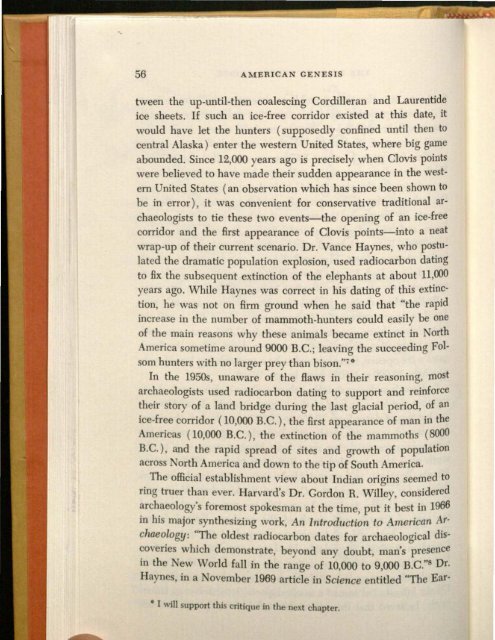Create successful ePaper yourself
Turn your PDF publications into a flip-book with our unique Google optimized e-Paper software.
56 AMERICAN GENESIS<br />
tween <strong>the</strong> up-until-<strong>the</strong>n coalescing Cordilleran <strong>and</strong> Laurentide<br />
ice sheets. If such an ice-free corridor existed at this date, it<br />
would have let <strong>the</strong> hunters (supposedly confined until <strong>the</strong>n to<br />
central Alaska) enter <strong>the</strong> western United States, where big game<br />
abounded. Since 12,000 years ago is precisely when Clovis points<br />
were believed to have made <strong>the</strong>ir sudden appearance in <strong>the</strong> western<br />
United States (an observation which has since been shown to<br />
be in error), it was convenient for conservative traditional archaeologists<br />
to tie <strong>the</strong>se two events-<strong>the</strong> opening <strong>of</strong> an ice-free<br />
corridor <strong>and</strong> <strong>the</strong> first appearance <strong>of</strong> Clovis points-into a neat<br />
wrap-up <strong>of</strong> <strong>the</strong>ir current scenario. Dr. Vance Haynes, who postulated<br />
<strong>the</strong> dramatic population explosion, used radiocarbon dating<br />
to fix <strong>the</strong> subsequent extinction <strong>of</strong> <strong>the</strong> elephants at about 11,000<br />
years ago. While Haynes was correct in his dating <strong>of</strong> this extinction,<br />
he was not On firm ground when he said that "<strong>the</strong> rapid<br />
increase in <strong>the</strong> number <strong>of</strong> mammoth-hunters could easily be one<br />
<strong>of</strong> <strong>the</strong> main reasons why <strong>the</strong>se animals became extinct in North<br />
America sometime around 9000 B.C.; leaving <strong>the</strong> succeeding Folsom<br />
hunters with no larger prey than bison."'·<br />
In <strong>the</strong> 1950s, unaware <strong>of</strong> <strong>the</strong> flaws in <strong>the</strong>ir reasoning, most<br />
archaeologists used radiocarbon dating to support <strong>and</strong> reinforce<br />
<strong>the</strong>ir story <strong>of</strong> a l<strong>and</strong> bridge during <strong>the</strong> last glacial period, <strong>of</strong> an<br />
ice-free corridor (10,000 B.C.), <strong>the</strong> first appearance <strong>of</strong> man in <strong>the</strong><br />
Americas (10,000 B.C.), <strong>the</strong> extinction <strong>of</strong> <strong>the</strong> mammoths (8000<br />
B.C.), <strong>and</strong> <strong>the</strong> rapid spread <strong>of</strong> sites <strong>and</strong> growth <strong>of</strong> population<br />
across North America <strong>and</strong> down to <strong>the</strong> tip <strong>of</strong> South America.<br />
<strong>The</strong> <strong>of</strong>ficial establishment view about <strong>Indian</strong> origins seemed to<br />
ring truer than ever. Harvard's Dr. Gordon R. Willey, considered<br />
archaeology's foremost spokesman at <strong>the</strong> time, put it best in 1966<br />
in his major syn<strong>the</strong>sizing work, An Introduction to <strong>American</strong> Archaeology:<br />
'<strong>The</strong> oldest radiocarbon dates for archaeological discoveries<br />
which demonstrate, beyond any doubt, man's presence<br />
in <strong>the</strong> New World fall in <strong>the</strong> range <strong>of</strong> 10,000 to 9,000 B.C.". Dr.<br />
Haynes. in a November 1969 article in Science entitled "<strong>The</strong> Ear-<br />
• I will support this critique in <strong>the</strong> next chapter.


















